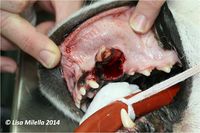Difference between revisions of "Luxated and Avulsed Teeth"
Jump to navigation
Jump to search
m (Text replace - "Category:LisaM reviewed]]" to "Category:Lisa Milella reviewed]]") |
|||
| Line 1: | Line 1: | ||
| + | {{OpenPagesTop}} | ||
==Introduction== | ==Introduction== | ||
[[File:Luxated tooth.jpg|200px|right|thumb|Luxated tooth]] | [[File:Luxated tooth.jpg|200px|right|thumb|Luxated tooth]] | ||
| Line 18: | Line 19: | ||
{{Waltham}} | {{Waltham}} | ||
| − | + | {{OpenPages}} | |
[[Category:Endodontic Conditions]] | [[Category:Endodontic Conditions]] | ||
[[Category:Traumatic Dental Conditions]] | [[Category:Traumatic Dental Conditions]] | ||
[[Category:Lisa Milella reviewed]] | [[Category:Lisa Milella reviewed]] | ||
[[Category:Waltham reviewed]] | [[Category:Waltham reviewed]] | ||
Revision as of 14:04, 2 November 2014
Introduction
Occasionally, veterinarians are presented with luxated or avulsed teeth.
Luxated = partly dislocated from the socket. The most common luxation is a lateral luxation together with fracture of the alveolar bone plate.
Avulsed = completely removed/pulled out of the socket
In these cases of trauma, the blood supply to the tooth is affected, resulting in pulp necrosis.
Injured teeth will require treatment - either extraction or replacement and stabilization, and once the tooth has re-attached, endodontic treatment will be required.
| This article was written by Lisa Milella BVSc DipEVDC MRCVS. Date reviewed: 13 August 2014 |
| Endorsed by WALTHAM®, a leading authority in companion animal nutrition and wellbeing for over 50 years and the science institute for Mars Petcare. |
Error in widget FBRecommend: unable to write file /var/www/wikivet.net/extensions/Widgets/compiled_templates/wrt662dc590116455_45096674 Error in widget google+: unable to write file /var/www/wikivet.net/extensions/Widgets/compiled_templates/wrt662dc590148210_14841533 Error in widget TwitterTweet: unable to write file /var/www/wikivet.net/extensions/Widgets/compiled_templates/wrt662dc590173935_42534208
|
| WikiVet® Introduction - Help WikiVet - Report a Problem |
